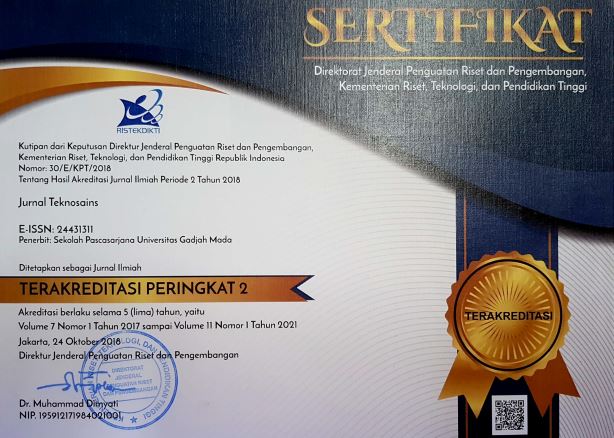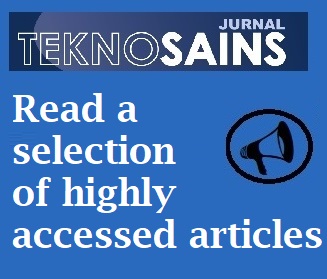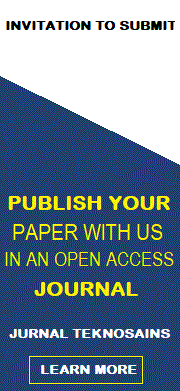OPTIMASI DESAIN STENT PLA MENGGUNAKAN METODE RESPONSE SURFACE (RSM) UNTUK MEMPEROLAH FLEKSIBILITAS TERBAIK
Sukiman B(1*)
(1) Universitas Gadjah Mada
(*) Corresponding Author
Abstract
The stent installation is one of cardiovascular disease treatments which is selected the most to handle patients with blood vessel disease. As the demand for stents increases, more researches are aimed at developing them. This study aims to obtain the optimal link design to produce the best flexibility to the change of stent angle with minimum stress so as not to injure blood vessel plaque. In this study, the stents are polymer stent with different types of links made with PLA materials with strut mirror (S><) design. The study was conducted on two stent configurations, namely crimped and expanded to determine the ability of angular change and maximum stress experienced by both when bending moment applied. The bending moment test was done through simulation based on finite element method in software Abaqus 6.14. The simulation results were then used as a model-making reference to determine the desired optimization design using the help of Minitab 18 software based on the response surface method. The results of this study indicate that the best optimal flexibility on crimped stent L1 to L5, which is the highest flexibility with von mises stress in the safety limit can be obtained based on a combination of link design parameters in the form of bending moment of 0.0074 N.mm with a thickness of 100 μm L3, and 0,0087 N.mm with a thickness of 106 μm L5. While at the expanded stent L1 to L5, the optimal link design parameter value for obtaining the best flexibility with von mises stress within the safety limit is a bending moment of 0.0075 N.mm with a thickness of 63.78 μm L3, 0.0067 N.mm with a thickness of 70 μm L5.
Keywords
Full Text:
PDFReferences
Akbari, R. A., 2013, Analisis Pengaruh Suhu Terhadap Kekuatan Surface Metal Seal (SMS) Packoff pada Unitized Wellhead Menggunakan Metode Elemen Hingga, Skripsi, Universitas Gadjah Mada.
ASTM D 638, 2000, Standard Test Method for tensile Properties of Plastics, ASTM International.
Bae, I.H., Lim, K.S., Park, J.K., Park, D.S., Lee, S.Y., Jang, E.U., Ji, M.S., Sim, Hong, Y.J., Ahn, Y., Park, J.C., Cho, J.G., Kang, J.C., Kim, I.S., Nah, J.W., dan Jeong, M.H., 2014, Mechanical Behavior and In Vivo Properties of Newly Designed Bare Metal Stent for Enhanced Flexibility, Journal of Industrial and Engineering Chemistry, 21, pp. 1295-1300.
Beule, M.D., 2008, Finite Element Stent Design, Thesis, Ghet University, Belgium.
Biotronik, 2017, PRO Kinetic Energy, http://www.biotronik.com/enus/products/ vi/coronary/pro-kinetic-energy (diakses online 15 Juni 2017).
Bobel A. C., Petisco S., Sarasua J. R., Wang W., and Mchugh P. E., 2015, Computational Bench Testing to Evaluate the Short-Term Mechanical Performance of a Polymeric Stent, Cardiovascular Engineering and Technology, vol. 6, No.4, pp 519-532.
Erbel, R., Haude, M., Hopp, W.H., Franzen, D., Rupprecht, H.J., Heublein, B., Fischer, K., Jaegere, P.D, Serruys, P., Rutsch, W., Prost, P., 1998, CoronaryArtery Stenting Compared with Balloon Angioplasty for Restenosis After Initial Balloon Angioplasty, The New England Journal of Medicine, Vol. 339, No. 23, pp. 1672-1678.
Fogarotto, F., 2011, Finite Element Analysis of Coronary Artery Stenting, Thesis, Hermawan, H., Dubé, D, dan Mantovani, D., 2010, Developments in metallic biodegradable stents, Acta Biomaterialia, vol. 6, pp. 1693-1697.
Hadiyat, M. A., 2012, Response-surface dan Taguchi: Sebuah Alternatif atau Kompetisi dalam Optimasi Secara Praktis, Prosiding Seminar Nasional Industrialisasi Madura, pp. 3345-3354.
Hoang, V., 2004, Stent Design and Engineer Coating Over Flow Removal Tool, http://www.me.ucr.edu/sendesign/0405/team3/Stent_Design.doc, diakses secara online pada 27 Mei 2017.
Kementerian Kesehatan RI, 2013, Situasi Kesehatan Jantung, http://www.depkes.go.id/download.php?file=download/pusdatin/infodatin/in fodatin-jantung.pdf (diakses online 1 Maret 2018).
Li, N., Zhang, H., Ouyang, H., 2009, Shape Optimization of Coronary Artery Stent Based on a Parametric Model, Finite Elements in Analysis and Design, Vol. 45, pp. 469-475.
Montgomery, D.C. dan Runger, G.C., 2003, Applied Statistics and Probability for Engineers, 3rd ed., John Wiley & Sons, New York.
Myers, R. H., Montgomery, D. C., & Anderson-Cook, C. M., 2009, Response surface methodology: process and product optimization using designed experiments, John Wiley & Sons, New York.
Nursetyati, P. S., 2017, Optimasi Parameter Desain BMS Berbahan Baku Cobalt Chromium L605 untuk Memperoleh Fleksibilitas Terbaik Menggunakan Metode Response Surface, Skripsi, Universitas Gadjah Mada.
Pant, S., Bressloff, N.W., Limbert, G., 2012, Geometry Parameterization and Multidisciplinary Constrained Optimization of Coronary Stents, Biomech Model Mechanobiol, Vol. 11, pp. 61-81.
Petrini, L., Migliavacca, Auricchio, F., dan Dubini, G., 2004, Numerical Investigation of the Intravascular Coronary Stent Flexibility, Journal of Biomechanics, vol. 37, pp. 495-501.
Sangiorgi, G., Melzi, G., Agostoni, P., Cola, C., Clementi, F., Romitelli, P., Virmani. R., Colombo, A., 2007, Engineering Aspects of Stents Design and Their Translation into Clinical Practice, Ann Ist Super Sanita, Vol. 43, No. 1.
Sastranegara, A., 2009, Mengenal Uji Tarik dan Sifat-sifat Mekanik Logam, http://www.infometrik.com/wpcontent/uploads/2009/09/Mengenalujitarik.pdf, [Diakses pada 17 Januari 2018].
Schiavone, A., Qiu, T., dan Zhao, L., 2017, Crimping and deployment of metallic and polymeric stents-finite element modelling, Vessel Plus Journal, vol. 1, pp. 12-21.
Septiani, E. G., 2017, Optimasi Parameter Desain Stent Berbahan baku Poly-L-Lactic-Acid (PLLA) untuk Memperoleh Fleksibilitas Terbaik Menggunakan Metode Response Surface, Skripsi, Universitas Gadjah Mada.
Sivaros, Milkey, K. R., Samsudin, A. R., Dubey, A. K., dan Kidd., P., 2014, Comparison Between Taguchi Method and Response Surface Methodology (RSM) in Modelling CO2 Laser Machining, Jordan Journal of Mechanical and Industrial Engineering, vol. 8, iss. 1, pp. 35-42.
Tontowi, A.E., Ikra, P., dan Siswomihardjo, W., 2013, Mapping of Cardivascular Stent Demand of Several Hospitals in Indonesia and Its Forecasting, Proceeding of ICICI 2013, Bandung, Indonesia Università degli Studi di Pavia, Italia.
Utami, A. S. M. K., 2017, Optimasi Parameter Desain Stent Dengan Linkage Terpilih Berbahan Baku Poly-L-Lactic Acid (PLLA) untuk Memperoleh Fleksibilitas Terbaik Menggunakan Metode Response Surface, Skripsi, Universitas Gadjah Mada.
WHO, 2015, World heath statistics 2015, https://doi.org/ISBN 978 92, diakses secara online 8 Agustus 2017.
Wu, W., Yang, D.Z., Qi, M., Wang, W.Q., 2007, An FEA Method to Study Flexibility of Expanded Coronary Stents, Journal of Materials Processing Technology, 184, pp. 447-150.
Young, P.G., Beresford-West, T.B.H., Coward, S.R.L., Notarberardino, B., Walker, B., Abdul-Aziz, A., 2008, An Efficient Approach to Converting ThreeDimensional Image Data into Highly Accurate Computational Models, Philosophical Transactions of The Royal Society, Vol. 366, pp. 3155-1373.
Zainuri, A., Sujita, Popo, A.L., 2010, Tegangan Maksimum dan Faktor Keamanan pada Poros Engkol Daihatsu Zebra Espass Berdasarkan Metode Numerik, Momen.
Article Metrics
Refbacks
- There are currently no refbacks.
Copyright (c) 2018 Sukiman B

This work is licensed under a Creative Commons Attribution-ShareAlike 4.0 International License.
Copyright © 2024 Jurnal Teknosains Submit an Article Tracking Your Submission
Editorial Policies Publishing System Copyright Notice Site Map Journal History Visitor Statistics Abstracting & Indexing









